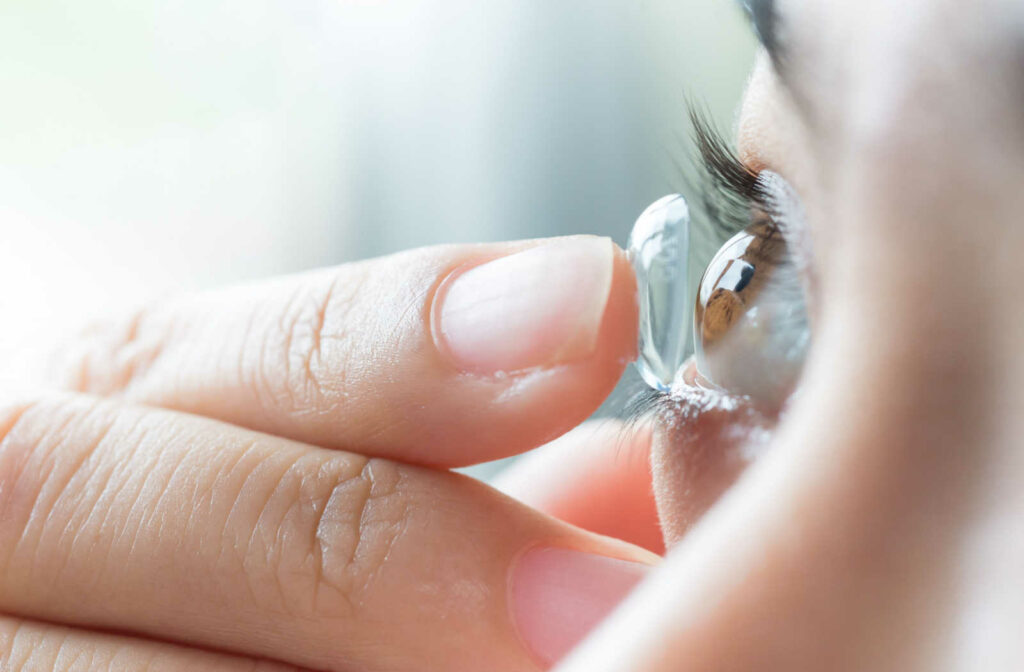Contact lenses are a vision correction devices placed directly on the eye’s surface. They alter the way light enters the eyes to provide clear vision.
They have become increasingly popular over the years due to their convenience and ability to provide clear vision without needing to wear eyeglasses.
Contact lenses can be safe and easy to use once you have a contact lens exam and fitting and understand how they work.
How Do Contact Lenses work?
Contact lenses correct how light enters the eye, just like traditional eyeglasses. But unlike eyeglasses, contact lenses sit directly on the eye’s surface, allowing for a more natural and unobstructed view of the world.
When light enters the eye, it reflects and focuses onto the retina (the light-sensitive tissue at the back of the eye) to produce a clear image. If light focuses in front of or behind the retina instead of on it, you can experience blurry or distorted vision.
Blurry vision is called a refractive error—and that’s where corrective glasses and contact lenses come in. Contact lenses change how light enters the eye, correcting refractive errors, such as nearsightedness, farsightedness, and astigmatism, so you can achieve clear vision.
Nearsightedness or Myopia
Nearsightedness, also known as myopia, is a common refractive error that causes distant objects to appear blurry or out of focus. It occurs when the eyeball is too long or the cornea too curved, causing the incoming light to focus in front of the retina instead of directly on it. Contact lenses can compensate for the steeply curved cornea or elongated eyeball to provide clear vision.
Farsightedness or Hyperopia
Farsightedness, also known as hyperopia, causes nearby objects to appear blurry or out of focus. It occurs when the eyeball is too short or the cornea doesn’t have enough curvature, causing the incoming light to focus behind the retina instead of directly on it. Contact lenses can help correct vision affected by farsightedness.
Astigmatism
Astigmatism occurs when the cornea or lens (inner part of the eye) causes light to focus unevenly on the retina. It can cause impaired vision at all distances.
With astigmatism, the cornea or lens has a different shape than normal, causing light to focus at different points on the retina, resulting in blurry, distorted vision. Astigmatism can be corrected with specialty contacts called toric lenses, which are weighted to ensure they maintain the correct position on the eye.
Types of Contact Lenses
Contact lenses come in various materials and designs to suit different needs and preferences. Types of contact lenses can include:
- Soft hydrogel lenses, which allow oxygen to reach the eye. Many people find soft lenses comfortable to wear.
- Rigid gas permeable (RGP) lenses, which are stiffer than soft contacts, more durable, and provide sharper vision for some people.
- Hybrid lenses, which have a rigid center with a soft outer ring to provide the comfort of a soft lens and the crisp vision of a rigid lens.
- Scleral lenses, which vault over the cornea and rest on the sclera (white part of the eye), making them a viable option for people with dry eyes.

How to Find the Right Contact Lenses
Contact lens exams and fittings are vital to finding the right contact lens for your eyes. This exam evaluates whether someone is a good candidate for wearing contact lenses and determines the best type and fit for their unique eyes.
During a contact lens exam and fitting, your eye doctor can assess your eye health and check for vision problems and underlying eye conditions. They can also measure the curvature of the cornea and the size of the pupil to determine the best type and fit of contact lenses.
Once your eye doctor has determined the appropriate contact lens prescription, they can perform a contact lens fitting and teach you how to properly insert and remove your contact lenses. Your optometrist may encourage you to try out your new lenses and return for a follow-up appointment to see how they are fitting in case adjustments are needed.
It is important to note that a contact lens exam and fitting is not the same as a regular eye exam. If you are interested in trying contact lenses, it’s best to speak with your optometrist before your appointment.
Caring for Your Contact Lenses
While contact lenses can be more convenient than glasses, they require more care to prevent infection.
You can follow these easy tips to help keep your eyes healthy and practice good contact lens hygiene:
- Wear your contact lenses only for the length of time recommended by your optometrist.
- Clean and disinfect your lenses as prescribed by your eye doctor or the manufacturer.
- Use the cleaning and disinfecting system prescribed by your eye doctor.
- Keep up with regular eye examinations.
- Avoid sleeping or napping in your contacts unless specifically indicated.
- Consult your eye doctor before using eye medications or eye drops.
Vision Correction that Looks & Feels Natural
With proper care, contact lenses can provide clear and comfortable vision. Book an appointment with Alcona Eye Care Centre to find contact lenses for your vision needs.




